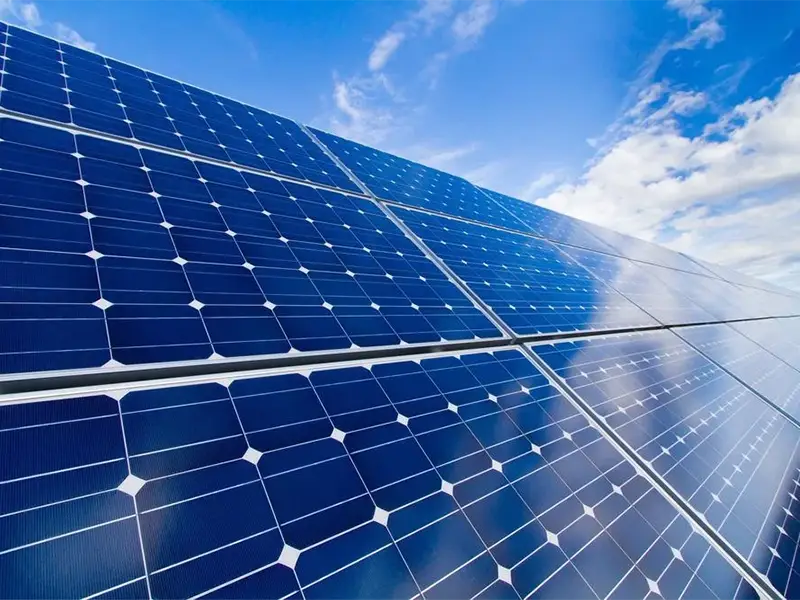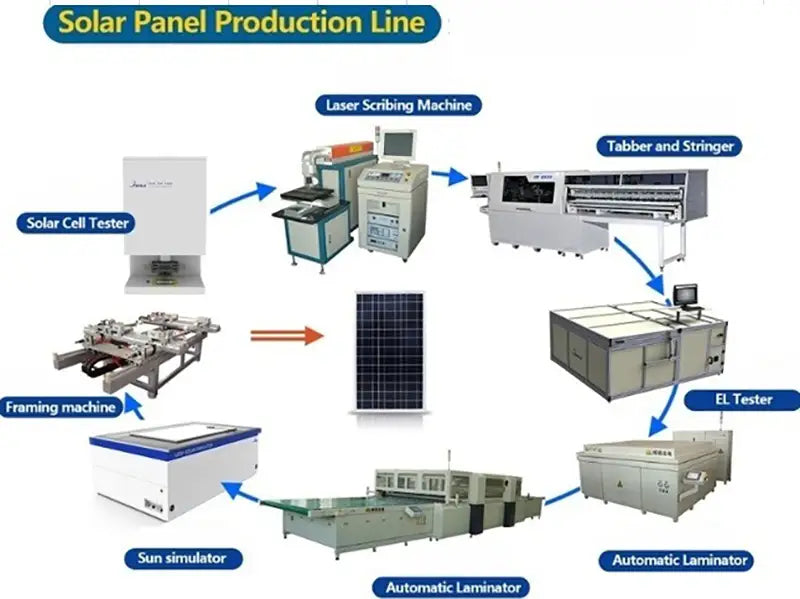
Main content:
- Solar battery manufacturing: selection of silicon wafers
- Solar battery manufacturing: surface preparation
- Solar battery manufacturing: Diffusion junction
- Solar battery manufacturing: Removal of Back Junction
- Solar battery manufacturing: fabrication of upper and lower electrodes
- Solar battery manufacturing: Corrosion surrounding
- Solar battery manufacturing: Evaporated anti-reflection film
- Solar battery manufacturing: inspection and testing
- Solar battery manufacturing: encapsulation of monocrystalline silicon solar battery modules
There are many solar battery manufacturing methods and types of solar batteries, and currently the most used ones are monocrystalline silicon and multi-product silicon solar batteries. This solar battery is technically mature, stable and reliable in performance, and has high conversion efficiency. It has been industrialized and mass-produced. The structure of a single crystal silicon solar battery is shown in the figure below, in fact, it is a large-area semiconductor PN junction. The upper surface is the light-receiving surface, and the grid electrode made of aluminum-silver material is vapor-deposited; the back surface is the bottom electrode made of nickel-tin layer. Both the upper and lower electrodes are welded with silver wires as lead wires. In order to reduce the reflection of the incident light on the surface of the silicon wafer, an anti-reflection film of silicon dioxide or other materials is evaporated on the surface of the cell.

The general method of single crystal silicon solar battery manufacturing is briefly described below.
1. Solar battery manufacturing: selection of silicon wafers
Silicon wafer is the basic material for manufacturing single-product silicon solar cells, which can be cut from monocrystalline silicon rods with high purity. When selecting a silicon wafer, the conductivity type, resistivity, crystal orientation, dislocation, and lifetime of the silicon material should be considered.
Silicon wafers are usually processed into squares, rectangles, circles or semi-circles with a thickness of about 0.25~0.40mm
2. Solar battery manufacturing: surface preparation
Sliced silicon wafers with dirty and uneven surfaces. Therefore, before solar battery manufacturing, surface preparation is performed. Surface preparation is generally divided into three steps:
①Use hot concentrated sulfuric acid for preliminary chemical cleaning;
②Corrosion of silicon wafers in acidic or alkaline etching solution, each wafer is etched to a thickness of about 30~50μm;
③ Use aqua regia or other cleaning solution for chemical cleaning.
After chemical cleaning and etching, the wafers are rinsed with high-purity deionized water.

3. Solar battery manufacturing: Diffusion junction
The PN junction is the core part of single crystal silicon solar cells. Without the PN junction, photocurrent cannot be generated, so it is not called a solar cell. Therefore, the fabrication of the PN junction is the most important process. High temperature diffusion method is usually used to make the junction. Taking the diffusion of phosphorus on a P-type silicon wafer as an example, the main diffusion steps are:
①The preparation of diffusion source. Dissolve ultra-pure phosphorus pentoxide in an appropriate amount of ethanol or deionized water, shake well, and then dilute.
② Tu source. Take out the surface-prepared silicon wafer from deionized water, dry the coating source under infrared light to make it evenly dispersed on the silicon surface, and then dry it slightly with infrared light, then put the silicon wafer into the quartz boat .
③ Diffusion. The diffusion furnace is pre-heated to the diffusion temperature, at a temperature of about 900°C-950°C, and nitrogen is purged for several minutes. Then, push the quartz boat with silicon wafers into the quartz tube in the furnace, preheat for a few minutes at the furnace mouth, and then push it into the constant temperature zone for more than ten minutes of diffusion, pull the quartz boat to the furnace mouth, and slowly cool for several minutes. Minutes, take out the silicon wafer, and the junction process is completed.
4. Solar battery manufacturing: Removal of Back Junction
During the high temperature diffusion process, a PN junction is also formed on the backside of the silicon wafer, and the backside junction must be removed. When removing the back junction, use black glue to coat the front side of the silicon wafer to mask the PN junction on the front side, and then place the silicon wafer in the etching solution to etch the back diffusion layer to obtain a flat and bright silicon wafer on the back side. , remove the vinyl, wash and dry the silicon wafer for later use.
5. Solar battery manufacturing: fabrication of upper and lower electrodes
In order to output the electric energy obtained by the battery conversion, two electrodes, positive and negative, must be made on the battery. The electrode on the light side of the battery is called the upper electrode; the electrode on the back of the battery is called the lower electrode. The upper electrode is usually made into a grid line, which is conducive to the collection of the generated current and enables the battery to have a larger light-receiving area. The lower electrode is all over the back of the battery to reduce the series resistance of the battery. When making electrodes, place the silicon wafer in the bell jar of the vacuum coating machine. When the vacuum degree is high enough, an aluminum film will condense on the surface of the silicon wafer, and its thickness can be controlled at 30-100μm. Then, a layer of silver is evaporated on the aluminum film with a thickness of about 2~5μm. In order to facilitate the assembly of the battery, a layer of tin-aluminum-silver alloy solder needs to be brazed on the electrodes. In addition, in order to obtain a grid-shaped upper electrode, a metal mask of a certain shape needs to be placed on the silicon surface when aluminum and silver are evaporated. The grid line density of the upper electrode is generally 4 lines per square centimeter, up to 10-19 lines per square centimeter, and up to 60 lines per square centimeter.
6. Solar battery manufacturing: Corrosion surrounding
During the diffusion process, a diffusion layer is also formed on the surrounding surface of the silicon wafer, which is usually removed when the back junction is etched, so this process can be omitted. If the perimeter of the cell has metal sticking to it during brazing, it will still need to be corroded to remove the metal. This process has a great impact on the performance of the battery, because any small partial short circuit will make the battery bad and even make it waste. The method of etching the surrounding is relatively simple, as long as the two sides of the silicon wafer are coated with black glue or masked by other methods, and then put into the etching solution to corrode for 30s or 1min.
7. Solar battery manufacturing: Evaporated anti-reflection film
The reflection loss rate of light energy on the silicon surface is about 1/3. In order to reduce the reflection of light on the silicon surface, an anti-reflection film of silicon dioxide, titanium dioxide or tantalum pentoxide should be evaporated on the silicon surface by vacuum coating method. Among them, the process of evaporating silicon dioxide film is mature and easy to manufacture, which is commonly used in current production. The anti-reflection film can improve the utilization rate of light energy of the solar cell and increase the power output of the battery.

8. Solar battery manufacturing: inspection and testing
Batteries produced through the above processes must be tested before being put into storage as finished batteries to check whether their quality is qualified. The main test in production is the volt-ampere characteristic curve of the battery. From this curve, parameters such as short-circuit current, open-circuit voltage, maximum output power, and series resistance of the battery can be known.
9. Solar battery manufacturing: encapsulation of monocrystalline silicon solar battery modules
In actual use, monolithic solar cells should be connected in series and parallel, sealed in a transparent casing, and assembled into a solar cell module. This sealed assembly prevents atmospheric corrosion and extends battery life. The modules are connected in series and parallel to form a solar cell array with a certain output power.
Described above is only the fabrication of a conventional monocrystalline silicon solar cell. At present, some factories also adopt other processes according to their actual conditions, but they are all similar. In order to further reduce the cost of solar cells, many factories have recently adopted many new processes and technologies for making solar cells. For example, selective corrosion is used on the surface of the battery to reduce the surface reflectivity; screen printing electroless nickel plating or silver paste sintering process is used to prepare the upper and lower electrodes; the anti-reflection film is deposited by spraying method, and then on the solar cell. The use of high-vacuum coating machine is omitted during production. All of these can greatly reduce the process cost of solar cells and greatly increase the yield. Other new processes such as ion implantation, laser annealing, laser doping, and molecular beam epitaxy have also been applied to varying degrees.